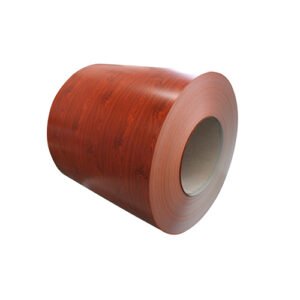Introduction:
Color coated aluminum coil is a versatile material that possesses a unique combination of properties, making it suitable for a wide range of applications. This essay explores the properties and manufacturing process of color coated aluminum coil, shedding light on its key characteristics and the techniques involved in its production.

Lightweight: Aluminum is known for its lightweight nature, making color coated aluminum coil an ideal choice for applications where weight reduction is crucial, such as in the automotive and aerospace industries. Its low density facilitates easier handling, transportation, and installation.
Excellent Durability: Color coated aluminum coil exhibits exceptional durability due to the combination of the aluminum substrate and the protective coating. Aluminum is inherently corrosion-resistant, and the coating further enhances its resistance to weathering, UV radiation, and chemical exposure. This durability ensures the longevity of the coil, making it suitable for both interior and exterior applications.
Aesthetic Appeal: The coated aluminum coil offers a vibrant and eye-catching range of colors and finishes. Architects and designers appreciate the ability to achieve their desired aesthetic vision with a vast palette of options. The coil can be customized to match specific design requirements, adding a touch of elegance and enhancing the overall visual appeal of structures and products.
Weather Resistance: Color coated aluminum coil is highly resistant to weather elements, making it an ideal choice for outdoor applications. It withstands extreme temperatures, humidity, and exposure to sunlight without fading or deteriorating. This property ensures its stability and performance even in harsh climatic conditions.
Surface Preparation: The aluminum substrate undergoes surface treatment processes to ensure optimal adhesion and corrosion resistance. It is cleaned, degreased, and chemically treated to create a suitable surface for the application of the coating.
Coating Application: The coating material is applied to the aluminum coil using various methods such as roll coating, spray coating, or powder coating. Roll coating involves passing the coil through a series of rollers, where the coating is uniformly applied. Spray coating utilizes a spray gun to disperse the coating material onto the coil surface, while powder coating involves electrostatically applying dry powder particles that adhere to the substrate.
Curing and Drying: After the application of the coating, the coil goes through a curing process to ensure proper adhesion and durability. Curing can be achieved through heat treatment or exposure to ultraviolet light, depending on the type of coating used. The coil is then dried to remove any moisture and solidify the coating.
Finishing: The color coated aluminum coil can undergo additional finishing processes to achieve desired textures and appearances. This includes options such as glossy, matte, textured, or metallic finishes, allowing for further customization and versatility.


Conclusion
Color coated aluminum coil possesses an array of desirable properties, including lightweight nature, excellent durability, aesthetic appeal, and weather resistance. The manufacturing process involves surface preparation, coating application, curing, drying, and optional finishing techniques. These properties and the manufacturing process make color coated aluminum coil a preferred choice in various industries, such as construction, automotive, and electronics. Its versatility and ability to combine aesthetics with durability make it a material of choice for architects, designers, and manufacturers seeking reliable and visually appealing solutions.